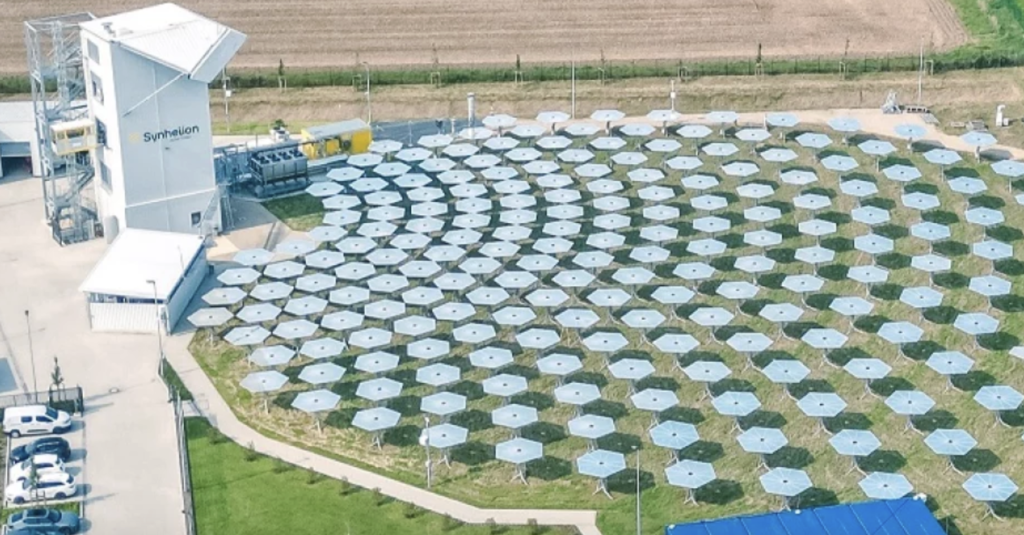Sign up for CleanTechnica’s Weekly Substack for Zach and Scott’s in-depth analyses and high level summaries, sign up for our daily newsletter, and/or follow us on Google News!

Last Updated on: 20th April 2025, 03:01 pm
Concentrating solar power enjoyed a brief spurt of funding attention from the US Department of Energy back during the Obama administration, but private investors never picked up the ball. Now the solar fuels movement is breathing new life into the field. The latest example is the Swiss firm Synhelion, which is bringing its sunlight-to-fuel technology to Spain following a successful test run of its pilot facility in Jülich, Germany.
Concentrating Solar Power Meets Solar Fuels
The hookup between concentrating solar power and solar fuels has been years in the making. Concentrating solar power plants deploy a field of specialized mirrors to focus sunlight onto a central point, where it heats up a molten salt or another heat-retaining fluid, which can be used to make steam for turbines or provide heat for other industrial processes.
While more complicated than the more familiar arrays of solar panels, concentrating solar does something that solar panels cannot. The working fluid acts as an energy storage medium, enabling the system to continue operating long after the sun sets.
By 2014, the Energy Department was supporting five CSP plants in the optimal, sunny conditions of the Southwest. The private sector investment community did not carry the idea any further here in the US, though activity continued in other parts of the world.
Still, science never sleeps. Under the direction of former Energy Secretary Rick Perry, the first Trump administration continued to support concentrating R&D. By 2018 — knee deep into Trump’s first term — researchers were exploring the idea of leveraging high heat from concentrating solar systems to provoke a thermochemical reaction in water, to combine hydrogen with carbon from the air to produce solar fuels.
Concentrating Solar Power And The Synhelion Connection
The solar fuels movement continued cranking up to speed after Trump reluctantly concluded his first term in office. In 2022, researchers at the National Renewable Energy Laboratory proposed a thermochemical system for producing green hydrogen from water, in which 1,400-degree (C) heat from a CSP system is deployed on metal oxides. The system expels hydrogen when lower-temperature steam is introduced.
While the US research was humming along, research teams in other parts of the world were already taking steps towards leveraging concentrating solar power for solar fuel production. One project to surface on the CleanTechnica radar was a high-performing, 3-D printed solar fuel system developed by the Swiss Federal Institute of Technology in Zurich (aka ETH), which licensed the technology to its spinoff Synhelion.
“Synhelion has already laid plans for a demonstration scale solar kerosene jet fuel plant in Germany integrated with a concentrating solar power plant, with Swiss International Air Lines lined up to test the fuel in its aircraft,” CleanTechnica reported in 2023.
The new facility, under the name “Plant DAWN,” was up and running in Jülich, Germany, by late summer last year. Synhelion reports that the operation is surpassing expectation. “Just a few months after commissioning, plant DAWN is operating close to nameplate capacity,” Synhelion noted in a press release on April 5.
“Industrial-scale solar fuel production at DAWN has proven and de-risked our technology and demonstrated that the technology and the company are ready for commercial fuel production,” they emphasized, aiming to draw the attention of private sector investors.
“The construction and operation of DAWN demonstrates Synhelion’s ability to deliver complete plant projects on time, on budget, and fully functional as designed,” Synhelion added for good measure.
Next Steps For Solar Fuels
The DAWN solar fuels facility deploys a brick-type thermal energy storage system along with two kinds of solar power to drive its thermochemical reaction on a 24/7 basis. In addition to a field of heliostats for the concentrating solar system, the facility also hosts an array of solar panels. “Our benchmark is to be able to store and discharge heat throughout the night, i.e. for around 16 hours. This requires several hundred megawatt-hours of storage capacity and determines the size of the thermal storage,” Synhelion explains.
As for why not simply use lithium-ion batteries for energy storage, Synhelion has an answer for that. “Our thermal energy storage technology is at least ten times cheaper than battery storage,” the company states, adding that the thermal storage supply chains avoids the environmental and human rights issues that can bedevil Li-ion batteries.
Commercial scale-up is still off in the future, but not too far off. “The insights gained from DAWN’s operation will accelerate the development of larger-scale plants, bringing solar fuels closer to widespread commercial adoption,” Synhelion explains. “The solar fuels produced at DAWN will be used in various showcase applications, demonstrating their viability and impact in real-world scenarios.”
Concentrating Solar Power Is Having A Moment
Synhelion is not waiting for the solar fuel grass to grow under its feet. The company already has a follow-on project called RISE in the works, to be located in Spain. Described as the company’s first commercial facility, RISE is expected to begin operating in 2027.
“By 2033, we plan to ramp up production capacity to produce 1 million tons of solar fuel per year,” Synhelion notes. “By 2040, we aim to ramp up fuel production to cover half of European SAF demand.”
In February, the Arabic-language news organization Asharq also reported that Synhelion is planning a 100,000-tonne (about 110,230 US ton) solar fuel facility. Morocco won out among other potential sites based on its existing industrial platform and its access to raw materials, in addition to enjoying premium solar resources.
Synhelion is not the only one pushing the concentrating solar power envelope. Last August, the firm Wood Mackenzie hosted an article by Ed Crooks, who holds the position of Vice Chair Americas and hosts the “Energy Gang” podcast.
The article is titled “The extraordinary comeback of concentrating solar power.” Though, Crooks and his podcast guests advised that technology hurdles and investor shyness continue to slow the pace of commercial development, at least here in the US.
“The steep learning curve and capital intensity of CSP plants is a particular barrier to deployment at the moment, as is the risk associated with building large thermal plants,” Crooks observed.
Crook also noted that as of last summer, the Energy Department had more than two dozen concentrating solar power research projects underway, totaling almost $100 million.
No word yet on whether or not those projects will be suspended or clawed back by the maliciously incompetent Commander-in-Chief who occupies the White House. If Trump is good at anything, he’s good at convincing energy infrastructure investors that investing in the US is a high-risk proposition. Now that Trump has established a practice of breaking federal contracts at whim, investor dollars are scurrying away to other nations.
As for Trump’s wanton breaking of the social contract, that’s a whole ‘nother can of worms. If you have any thoughts about that, drop a note in the comment thread. Better yet, find your representatives in Congress and let them know what you think.
Photo (cropped): Solar fuels are beginning to support the economic case for concentrating solar power plants, which produce high heat by focusing sunlight on a transfer medium (courtesy of Synhelion).
Whether you have solar power or not, please complete our latest solar power survey.
Have a tip for CleanTechnica? Want to advertise? Want to suggest a guest for our CleanTech Talk podcast? Contact us here.
Sign up for our daily newsletter for 15 new cleantech stories a day. Or sign up for our weekly one if daily is too frequent.
CleanTechnica uses affiliate links. See our policy here.
CleanTechnica’s Comment Policy



